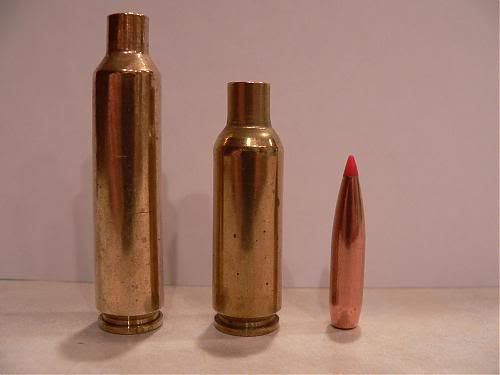6.5 Redux
MLC -
Hey... it worked !
The provisional " 6.5 Redux " wildcat case you see in the previous post reply
is one of my forming experiments.
Please note:
I formed cases ( 6.5 X 284 brass run up into a .264 Win Mag form die ) with nominal case capacities of 42, 44, and 46gr powder.
I only had the 42gr version still laying around, and sent a pic of THAT case.
Naturally, a 44 or 46gr capacity version would be longer in its base-to-shoulder dimension. I could always form up a 44gr caoacity case, for your viewing pleasure; if need be. Still, the 42gr size should give SOME idea.
( I measure capacity w/ a fine surplus ball powder, and an O'Haus
" Dial-A-Grain" beam scale ).
Please note:
The pic shows a standard 6.5 X 284 case on the Lt, the 65. Redux in the
middle; and a 6mm 105 "A"-Max on the Rt..... to give some sense of scale.
*** I had no 6.5mm bullets on-hand.
Both case's have outter neck diameters on the order of .290".
This is before either got a final "detail" outer neck turn.
For an AR application, the base-to-shoulder dimension and shoulder angle
would get played like a Stradivarius. The chosen neck angle then, affecting available neck length.
Some folks can't abide anything other than a long neck, others are content
with shorter necks; as-long-as adequate bullet grip can be assured.
The .264 Win Mag has a 25* shoulder angle. The Redding .264 Win Mag
" form " die I used to bend-up the 6.5 Redux widlcat brass likewide imparts a 25* shoulder angle to the wildcat brass. Naturally, sharpening the shoulder angle " frees-up " addtinional neck length; which in-turn helps keep the " turbulence point " inside the neck.
For a bolt-gun application, the6.5 Redux coudl be utilized w/ a benign 25* shoulder angle. In that case, stock .264 Win Mag dies could be used to both form the 6.5 Redux brass; and also for loading the cases.
**** Sharpening the shoulder would require the addition of either a custom shoulder angle forming die ( which would be used the brass after it
emerges fromthe .264Win Mag form die; or...... iuse of some other appropriately-sized and dimensioned forming " tool ".
To save on wildcattring costs, my 6.5 Redux case forming experiments made use of a special spark-plug tool ( a low-cost " proof-of-concept
approach ). The special spark plug tool imparted a quasi-hemispherical
shoulder surface to the sample brass.
Putting a sharper than 25* shoulder angle on 6.5 Redux would also drive one towards use of a " custom " chamber reamer. That could be as simple as
having a standard .264 Win Mag reamer re-ground to provide a sharper shoulder angle. The reamer then, woud be run-in " short ", to obtain the 6.5 Redux chamber.
If one has a .264 Win Mag barrel of proper porportions, it might even be possible to have it set-back and threaded to obtain a simple 6.5 Redux test " mule "; as proof-of-concept. Straight breech-section length of such a barrel is the key consideration in that scenario.
As regards " doughnuts ":
6.5 Redux makes use of the bottom-end of the 6.5 X 284 parent brass.
This gives one pretty stout brass, as this is the thickest-walled portion
of the brass. Combined with the notable shoulder shove, the need for inside neck reaming becomes apparent. This task is no great challenge
to perform, esp nowadays, with the wide-spread use of mechanized case
neck reamers / neck turners / case trimmers; et al.
6.5 Redux was an off-shoot of a similar 6mm wildcat, I was working up for a highpower shooter. To obtain the 6mm wildcat variant, I simply inside neck reamed and outside neck turned down the thick necks to obtain the final 6mm calibre desired. That process worked fine.
Some may not abide having to deep-seat 6.5mm Match bullets ( esp VLDs ),
for an " AR " application when /where a magazine is used.
For others, some encroachment of the powder space is tolerable, or is at least ok; for single-loaded rounds.
Best of luck in your endeavors.
Regards,
.357Mag


